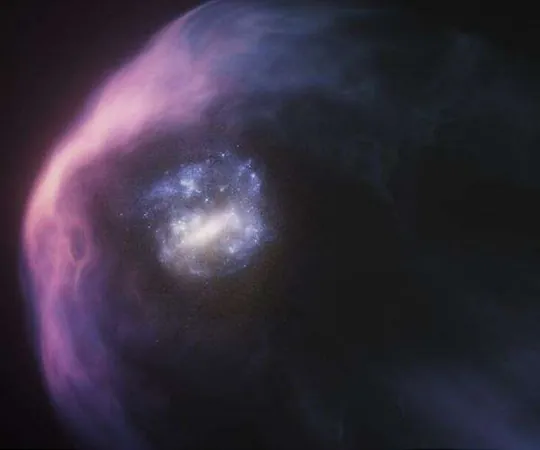
Stunning Hubble Discoveries: The Large Magellanic Cloud's Battle with the Milky Way!
2024-11-15
Author: Yu
Revelations from the Hubble Space Telescope
In a groundbreaking observation, the NASA/ESA Hubble Space Telescope has unveiled remarkable insights into the Large Magellanic Cloud (LMC), one of the Milky Way's closest dwarf galaxy neighbors. Located in the southern sky and spanning an area 20 times the width of the full Moon, the LMC has recently experienced a dramatic encounter with the Milky Way's gaseous halo. This interaction has led to a significant loss of its surrounding gas but still allows the LMC to retain enough material for ongoing star formation—a true testament to its resilience!
The LMC's Path Through the Milky Way
The LMC is currently theorized to be making a passage through the Milky Way rather than just orbiting it, having just passed its closest point. This close approach decimated a large portion of its gaseous halo, forcing astronomers to rethink how such interactions shape distant galaxies.
Understanding the Halo of the LMC
Amazingly, Hubble's advanced capabilities allowed researchers to measure the extent of the LMC's halo for the first time accurately. It turns out this halo is about 50,000 light-years wide—dramatically more compact than the halos of similar-sized galaxies. Andrew Fox, a principal investigator of the study, emphasized the LMC's robust nature, stating, "The LMC is a survivor. Despite losing significant gas, it still possesses enough to continue creating new stars. Smaller galaxies wouldn't have endured—only aging stars would be left behind."
Ram-Pressure Stripping: A Causal Mechanism
At the heart of this gas loss is a phenomenon known as ram-pressure stripping. As the LMC traverses the Milky Way's denser halo, the immense pressure strips away gas, creating a trailing wake similar to a comet's tail. According to Fox, the Milky Way's fierce pushback has significantly diminished the original mass of the LMC’s halo, leaving only a compact remnant.
Future Implications for the Milky Way
Interestingly, although much of the gas has been displaced, there is a possibility that some of it may eventually fall back into the Milky Way. Still, scientists predict that the halo won’t be completely abandoned, as the LMC is now moving outward into the depths of space.
Harnessing Hubble's Capabilities
This exceptional research was facilitated by the Mikulski Archive for Space Telescopes at STScI, leveraging Hubble's unique ability to analyze ultraviolet light. By studying absorption patterns from 28 quasars, scientists could infer the properties of the LMC's halo using the Cosmic Origins Spectrograph (COS) to measure gas velocities accurately.
Significance of the LMC for Cosmic Studies
Not only does the LMC serve as a living laboratory for galactic study, but it also offers significant revelations about cosmic interactions reminiscent of those in the early Universe. Professor Carole Mundell from the European Space Agency remarked on the importance of these findings, highlighting Hubble's continued relevance in deepening our understanding of the Milky Way's complex history with its satellite galaxies.
Looking to the Future: Further Research on the LMC's Halo
Looking ahead, future research aims to unveil the mysteries of the uncharted front side of the LMC's halo. Co-author Scott Lucchini from the Center for Astrophysics | Harvard and Smithsonian explained that researchers will be focusing on five sightlines where the halos of the LMC and Milky Way collide. This area, where the halos compress against each other, resembles two balloons pushing together and promises to be a crucial aspect of ongoing cosmic inquiry.
Conclusion: Hubble's Ongoing Quest for Knowledge
Stay tuned as Hubble continues to unlock the secrets of our universe, revealing astonishing narratives of survival, resilience, and the ongoing drama of celestial interactions!



 Brasil (PT)
Brasil (PT)
 Canada (EN)
Canada (EN)
 Chile (ES)
Chile (ES)
 España (ES)
España (ES)
 France (FR)
France (FR)
 Hong Kong (EN)
Hong Kong (EN)
 Italia (IT)
Italia (IT)
 日本 (JA)
日本 (JA)
 Magyarország (HU)
Magyarország (HU)
 Norge (NO)
Norge (NO)
 Polska (PL)
Polska (PL)
 Schweiz (DE)
Schweiz (DE)
 Singapore (EN)
Singapore (EN)
 Sverige (SV)
Sverige (SV)
 Suomi (FI)
Suomi (FI)
 Türkiye (TR)
Türkiye (TR)